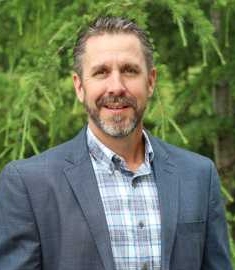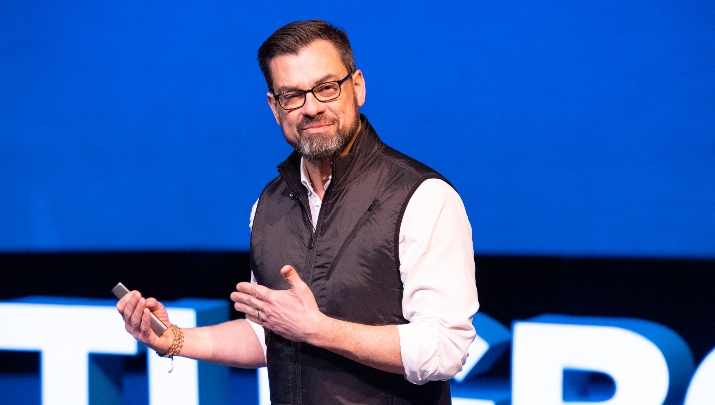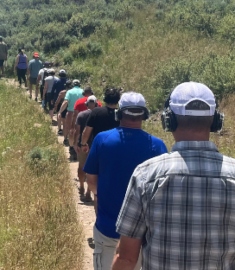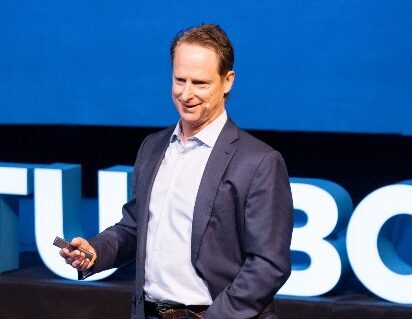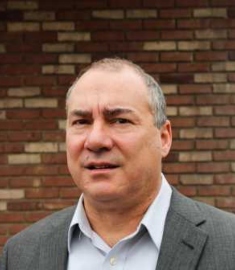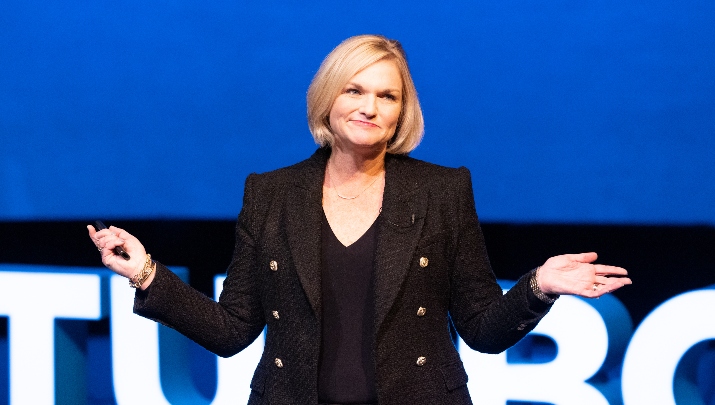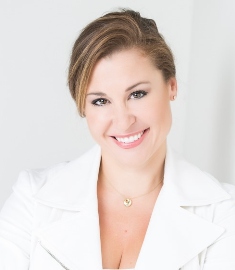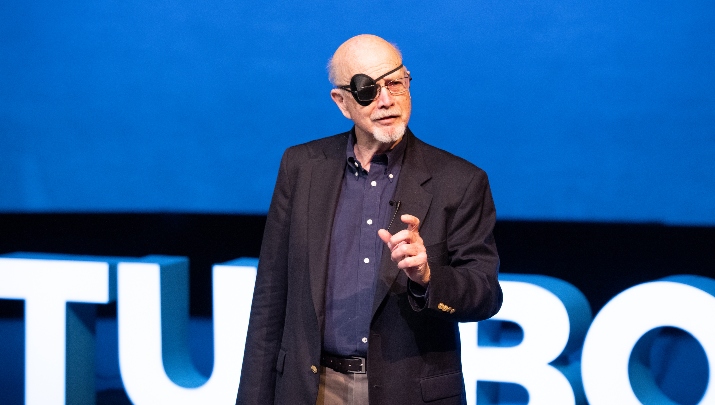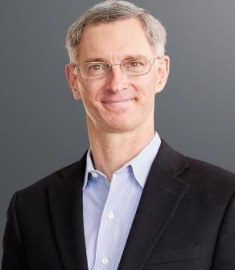Switching From Defense to Offense
As leaders of companies, we have all experienced downturns. The economy, the markets, the political climate, the weather, or an invisible virus can all crop up and cause things to shift in unexpected directions. An instinctual response to adversity is to pull up the drawbridge and prepare to hunker down and wait out the crisis, minimizing expenditure and risk. But as I look back on my last few years as President & CEO of R.A. Heath Construction and Millwork, Inc, I have learned something about myself; when the going gets tough, for better or worse, I switch from defense to offense.
Taking a risk and trying something new as the knee-jerk response to a slowdown is not what I advise. Recklessness is never recommended. However, I have learned that when certain conditions are met, it can be right to favor the bold move.
It might be fair to preface this story with the admission that a strong willingness to be bold and try new things has been part of our culture at R.A. Heath for years. I have gained confidence from some early moves that were a little risky but that turned out great. One example is from a several years ago, when remodeling was still the core of our business. We were strong in general and had even pioneered a method for remodeling a café or restaurant that allowed us to guarantee it would take no longer than two weeks. Starbucks, among others, has adopted this method for all its remodels, incidentally. But I thought we might be able to find ways to serve our customers even better.
Closing a restaurant or café for a remodel necessarily means lost business, which is a hardship for our clients. I started wondering if there might be a way to mitigate that. We were building temporary cafés for our clients so they could recoup sales while they were closed. This was time consuming and a big expense for each project. I joked with our client that I could just build out one of our construction trailers to sell coffee. That seemed like a great idea, so I took it one step further; we bought and built out a fleet of trailers to rent to our clients to use during their remodels. It was a big cost to us up front, but then we had a plan to help our clients retain some revenue, and to make money ourselves at the same time. This is an example of the mindset I strive to model and inspire at R.A. Heath, and certainly laid the groundwork for how we fared through a really big crisis.
As an Evergreen® leader, the first thing I need to know is that I can take care of my team. This priority drove some of the decisions we made in the weeks and months after Covid hit. Our industry, as everyone knows, all but ground to a halt in 2020. Many of my competitors started laying people off immediately to cut costs as revenue disappeared. Driven by the desire not just to hang onto my employees, but to create opportunities for them to thrive, I started looking for new ways to deploy our manpower.
My sister is in the restaurant business and early on, she started struggling to meet the new standards that might allow her to remain open. Dividers for her booths and tables suddenly became a high-priority item, but she found they were in short supply. I reflected; we had millworkers, construction workers, and construction equipment. I thought–we could make those! It soon became clear that the demand for these dividers would continue to grow, so we considered how we could make this product even more profitable. At first, we were buying a piece of molding from the guy down the road, but I thought–we could make that, too! We bought more equipment, invested in training and were soon producing every aspect of the dividers. We brought all the profit margin back in house, our team was busy and productive, and we had a new product line and revenue stream.
Another opportunity I saw as we moved into the slowdown was time. We had been so busy, and things had been moving so fast that we rarely had the luxury of being introspective. But when things slowed to a crawl during Covid, instead of sitting around wringing our hands, we decided to take the opportunity to study our processes and expose some of our weaknesses.
One thing we realized was that our entire cabinet-making division, which had been automated at great expense several years earlier, was not optimal. It depended on all parts of the process working perfectly, and a small glitch in one area could stop production completely. I was also conscious of the fact that running this automated process was not ideal for my employees; I am dedicated to helping them learn a trade, but we were instead just teaching them to push a button.
With the help of my accounting and finance teams, we looked at the numbers and decided to make a bold move; we shut down the automated process, got rid of the hundreds of thousands of dollars’ worth of machinery, and reverted to making our cabinets by hand. If we weren’t an Evergreen company, we never could have done this because it took time to build back to profitability. But now we are teaching a trade again, we are less vulnerable to work stoppages, and frankly, the quality of our cabinets has vastly improved. It was a good decision.
When the crisis started to abate and regular business returned, many of my competitors were not ready to meet the demand. But we had kept all our employees, diversified our products and services, and planned for the price increases and the surge that hit us. We were in a strong position to roar back to life–even stronger than we had been before the crisis.
As a result of our successes with offensive rather than defensive moves, in both the good times and the bad, I am proud to say that at R.A. Heath, I have led the establishment of a culture of open-mindedness; I am constantly coming at my team with new ideas, and they are ready to run with them. We don’t need a crisis to innovate and try new things. We’ve gained confidence from past successes, and we have a strong process for vetting new ideas, to help weed out the ones that are impractical and troubleshoot the ones that have promise. It has created a mindset of creativity and problem-solving throughout the organization, and has been the key to our success, even through challenging times. At R.A. Heath, we are not content to survive; we aim to thrive.
Simple Tools
Rich Ledbetter, COO of Guarantee Electrical, has had the good fortune to be guided through his career by several great thought leaders and inspiring people, starting with Muhammed Ali. He learned to take the best of each lesson and use them as building blocks for his own philosophy of leadership, which he has boiled down to what he calls his Simple Tools.
In this Tugboat Institute® talk, Rich shares the lessons gleaned from some of the people whose thinking has shaped his own the most, including Jim Collins, Simon Sinek, and Pat Lencioni. All three contributed significantly to Rich’s Evergreen® leadership philosophy. At the heart of the Simple Tools he has built from these building blocks is trust.
Watch and be inspired to consider your own sources of inspiration and the leadership tools in your own toolbox.
Tugboat Institute Summit 2022: Magic in the Mountains
Something extraordinary happened in Sun Valley last week. After two Tugboat Institute® Summits adapted to COVID, we were back in person in record numbers. The magic that happened throughout the week was clear evidence of the power and importance of our wonderful Evergreen® community.
Wednesday and Thursday mornings were spent hearing from 18 outstanding speakers on topics ranging from the exploration of different mechanisms to scale, to the sharing of personal challenges and journeys, to consideration of philosophies of leadership, to the importance of love.
The talks left us thinking in new ways, feeling deeply, and profoundly enlightened. Jeet Kumar of In Time Tec opened the talks on Wednesday by sharing his thoughts on love and leadership. His story opened our hearts and brought the audience, both in the theater and online, into a space of intimacy and support that was sustained throughout the rest of the experience. Lisa Ingram of White Castle shared what innovation looks like over time in a 100 year-old company. John Garrett of Community Impact Newspaper whetted our appetites for more conversation about the possibilities presented by partnerships with economic development groups in a short, 5-minute talk and then Dennis Jaffe, Senior Research Fellow at BanyanGlobal Family Business Advisors, shared his considerable wisdom about how to think about future generations as we consider the path forward for our businesses. We had an astounding and unique experience led by the entrepreneur, musician, and magical human being Murray Hidary. Murray shared his thinking on creativity and then invited us to connect with our creative centers as he performed an original, improvised piano concert. The experience was moving in unexpected and deeply profound ways. Following Murray’s performance, John McCullough of James Avery shared how and why James Avery became a vertically integrated company, and the competitive advantage it has given them. Mel Gravely of Triversity took the stage next for a 5-minute update on his thinking about conversations about race in America since he last presented on the topic at Summit 2021. Mel was followed by Courtney McKee of Headframe Spirits who shared her inspiring story of extraordinary perseverance and triumph in the face of challenges. Finally, Dave Thrasher of Supportworks shared his family’s journey scaling their company in a variety of ways, and the lessons learned through each experience.
The talks on Thursday were equally outstanding. We began the morning with a pre-recorded conversation between Dave Whorton and one of his heroes, the legendary Tom Peters, who spoke about his book In Search of Excellence and his current perspective on the topics he discussed in the book. Jane Blain Gilbertson of Blain’s Farm and Fleet told the story of fighting a private equity entrant into her markets; in her talk, she shared her disturbing and inspiring story of pulling her entire team together to beat a private equity-driven attempt to undo the Evergreen company her family had built over three generations. Bobby Jenkins of ABC Home & Commercial Services gave a 5-minute talk that offered insight into the opportunities available to businesses when they partner with their Chambers of Commerce, and then Samson Liu of SOH Dental shared his story of starting his own Evergreen company after the disillusionment of working in a company bought by private equity. We were then honored to invite Kevin Cahill, Executive Director of the W. Edwards Deming Institute, to the stage. Kevin shared his grandfather’s Deming philosophy with us, in particular the importance of looking at the shortcomings of the system, not team members, in People First companies. After Kevin, Brad Cleveland took the stage for a short, 5-minute talk on Leading the Customer Experience, which just happened to be inspired by a conversation he had with W. Edwards Deming very early in Brad’s career. Finally, Tugboat friend Anese Cavanaugh, Founder and CEO of Active Choices, brought us back to ourselves and invited us to consider self-care and self-partnership as essential leadership skills. Following Jeet’s powerful opening talk, Anese’s talk served as a wonderful bookend to the two days, during which we were exposed to ideas, practices, and stories that will help bolster our businesses, our families, and ourselves.
The afternoons were spent in dialogues with speakers over lunch, and then in a variety of activities that allowed attendees to share time in the beauty and magic of Sun Valley. We celebrated the friendships we cherish and got to enjoy, the new connections that we look forward to nurturing and growing over time, and the support and love of our incredible community.
Tugboat Institute Summit was magical, as it always seems to be when Evergreen leaders gather. Fortunately, we have more opportunities to gather again on the horizon!
On Purpose
Tugboat Institute® CEO Dave Whorton recently revisited the meaning of the first of the Evergreen 7Ps®: Purpose. His learning and thinking in recent years, and in particular through conversations with Tugboat members Penny Pennington of Edward Jones and Arturo Lomeli of Clase Azul, led him to conclude that it was time to revise our definition of Purpose.
In particular, in this Tugboat Institute talk, Dave reconsiders some of the teachings of economist Milton Friedman. Purpose must, he concludes, have Private as a partner in order to meaningfully and truly drive a company. Through this thoughtful and thorough reconsideration, Dave arrives at a revised definition of Purpose for Tugboat Institute and concludes, yet again, that the greatest calling for a company is to be an Evergreen® company.
Watch and understand how Purpose, along with Private, sit at the heart of the Evergreen movement.
Finding Room for Innovation in an Age-Old Industry
When you are selling a product that has been around for 4,000 years, it’s sometimes hard to see yourself as innovative. But even when your product–in this case milk–doesn’t evolve much, there is plenty of room for innovation in your processes and your business.
The milk business is a low-margin, commodity-based business that is highly regulated. Therefore, it can often seem like the right move to constantly look for ways to lower prices just a little, take some business from the competition, and drive volume up to increase your margin. But in my time as President of Turner Dairy Farms, I’ve learned that the seemingly ‘safe’ path is not always the best. As an Evergreen® business that is willing to innovate, pivot, and try new things, we have continued to grow and thrive since we were founded 92 years ago. In many cases, we’ve had to resist the urge to reach for what seems like the obvious answer because, just as often, it turns out it is not the best.
The first mistake many in our industry make is cutting corners and sacrificing taste. In the food industry, the results of customer surveys consistently tell the same story; the number one reason a consumer buys a food or beverage item is taste. Always. As soon as you start looking to cut corners, taste suffers and any advantage you may have gained evaporates. If your product doesn’t taste good, even at a lower price, customers won’t stay loyal.
A great example of this is chocolate milk. One of our biggest markets for chocolate milk is schools. A number of years ago, we had a competitor who gave us a lot of trouble because their prices were so low. They were winning a lot of school contracts. One day, we were doing a taste cutting of the chocolate milk brands in our market, which we do often, to make sure Turner’s Milk always tastes the best. The one from our competitor, who was beating us in the schools, came out of the carton and into the cup and it wasn’t even brown. It tasted awful and we couldn’t believe anyone would market that product!
Right as we were doing our taste-test, our chocolate supplier happened to stop by. We didn’t know it, but he was selling that substandard chocolate to our competitor. He didn’t say anything to us at the time, but he went home and talked his family into discontinuing that low-end product. This is an example of compromising values, and when you do, it eventually damages not only your relationships with your customers, but also with your suppliers and industry partners.
Another risk in our industry is customer boredom. Dr. John Stanton, Professor of Food Marketing at St. Joe’s, says that “the milk case is the great white tundra of the supermarket because it’s cold, white and nothing ever changes”. We accepted his challenge a few years ago and started playing with Limited Time Offerings (LTOs) on flavored milk–flavors like Chocolate Peanut Butter, Cookies N Cream, Chocolate Covered Strawberry and Birthday Cake! Initially, we made these to coincide with the big holidays. They were a hit, so we added some more at different points in the year. It was expensive and unpredictable, and we were always guessing about the demand and the supply we would need. Aside from creating little boosts in our sales periodically throughout the year, it did something else really positive; all of a sudden, customers had a reason to stop in front of the milk section. Imagine that! We found that sales of white and chocolate milk increased when we offered a fun flavor. An area of the store that historically held few surprises suddenly caught their attention and offered a novelty.
The LTO initiative was such a success that we have since brought it to the schools. We partner with the school nutrition teams to bring in a low-fat version of our best flavored milks a few times a year, just when interest in school lunch is waning, and kids are falling into a slump. A month or so into the fall semester, for example, when the excitement of going back to school has died down and routine sets in, we bring in a new milk like Cookies ‘n Cream. It’s fun, it’s different, and it gives them a little boost. Although we don’t charge our schools more for this milk, and you could therefore argue it’s not a very smart initiative, we have found that on at least two fronts it’s a win. First, the schools love it, and we win more contracts. Second, we are forging a relationship with kids who will, before we know it, become young adults and young parents. They are our future customers, and they will know and trust us and keep coming to us when the choice is theirs to make.
To be successful for 100 years we make different choices than we would if we only aimed to be successful for this year. When we shift the lens from the consumer to the employee, we feel strongly that many compromises that might save us money are not worth the cost. As an Evergreen business, we pride ourselves on taking great care of our employees, treating them like family, paying them a better wage than our competitors, and making sure they feel valued. Some of our huge, industrialized competitors run shifts 24 hours a day. We do not. We run one long shift each day so that we have the margin to do things right when problems arise. We are a medium sized operation, so our competitive advantage does not live in the high efficiency of the larger industrial dairies. Rather, it lives in the high quality of the personal attention to detail.
In the last ten years, the milk industry as a whole has only seen one year of sales volume growth, but Turner Dairy Farms has grown eight of those same ten years. As an Evergreen company, quality and values matter more than anything else. Obviously, we must be profitable to stay in business, but we focus first on protecting our constituents, and then on protecting the bottom line. Over the years, this strategy has been the key to our long-term success and growth.
If It Ain’t Broke Yet, Fix It
When you step into your family company as CEO, there are certain advantages and certain challenges. Kristi Tacony Humes learned this first hand when she took the reins of Tacony Corporation as the 3rd generation leader of her family’s sewing and cleaning supplies company. Above all else, she learned the importance of being willing to question the status quo and fix things…before they are broken!
In this candid and insightful Tugboat Institute® talk, Kristi shares her experience and lessons learned from her experience as CEO of Tacony. In her Evergreen® company, Kristi had the mandate to keep the heart of the company the same, all while making the changes necessary to shape it into its current, modern form.
Watch and learn more about the advantages and the challenges of being a leader of a family business.
Lessons From a Turnaround CEO
When I agreed to come on board as the turnaround CEO of SKG, the exclusive dealer of MillerKnoll furniture in Central, South, and West Texas, I understood two things very clearly. First, there were problems to fix. Second, the potential for a great company was there.
Although I had not yet adopted the lens and language of an Evergreen® Business, I can tell you now that when I joined SKG, they had several of our principles solidly in place, but were in great need of improvement on the others. SKG has always been a people first company, they have always had a strong culture, they have always been highly focused on the customer experience, and they have always been private.
My explicit task when coming on board was to help advance the profit and growth of SKG. I discovered, however, that there were other issues that needed to be addressed to get the turnaround underway. SKG lacked a clear purpose, and they were not an innovative organization.
The fundamental problem with the purpose of SKG when I joined was that not everyone agreed on what it was. The founder had a purpose that drove her work – people first – and some key board members had a different purpose – growth and profitability. To me, those were all important but sometimes came into conflict. We needed to unify around one clear purpose. I started driving change from the articulation of our new core compass: At SKG, we are innovative, we take care of people, and we drive impact in our community, both locally and globally. As I stepped into the work of rebuilding this company, I led with this vision.
I started with people. I had some great people on my team and many of them are still here today. But the organization, down to the physical space of the office, was all wrong. I had to get the right people in the right places, both literally and on the org chart. The process felt like a shake-up to some and was further complicated by the fact that the company’s founder was still in leadership and very present. I don’t think there is any other place to start when you set out to re-build a company and it was hard work.
I am an operator, so after the initial reshuffling was underway, I turned my attention to the team that would drive the profit and growth. As a growth-focused leader, I was able to see where the market potentials were and I focused my attention on making the changes and setting expectations in the sales department that would set us on a path for the growth I was targeting. This work was no easier than the work on the people front and I found myself spending as much time and energy dismantling the structures that were in place as I did on the rebuild. It was effective and in just about three years, we moved from a $13M business to a $60M+ business.
Once I had the organizational structure, the physical office, and the sales teams where I wanted them, I started a systematic review and restructuring of each department. I found as I went that we had to break down almost everything and rebuild it, from our target focus to our marketing and branding, our core operations systems, our service platforms, our trucks, our uniforms–everything!
We came out of the rebuild strong, focused on our purpose, and in a great place. Around this time, I was able to become a majority owner, so internal friction with the founder finally eased as well. We were able to charge forward on the innovation front, inspired by our new purpose, and I was extremely proud of the progress we had made. Then, Covid.
Through the pandemic, we lost a lot of ground and in the last year or so, I feel in a way like I have had to do the work of rebuilding SKG all over again. But this has also afforded us some great opportunities, especially on the innovation front. Business looks different than it did, so we should be a different company. We not only have to think about the changes to our own work environment, but since we are in the business of creating work environments for our customers, we are also able to engage in exciting re-visioning of what “creating a workplace” means. Although it’s been frustrating on some levels to do it all again, I am grateful that we had the new opportunity to improve and I love the way we are emerging from the pandemic – refreshed, new, and stronger than ever.
I am extremely proud of the work we did and what we were able to achieve, but hindsight allows me to see areas for improvement if I had it to do over. Our work meant a great deal of change for our employees, and it was tough. I assumed that as we re-structured, the culture and purpose pieces would naturally fall into place, and they did, but slowly. I spent an enormous amount of time and energy managing people in the early phase of the turnaround. In retrospect, if I had I brought on my HR Director right at the beginning, it could have helped us be more intentional about that work and lay out the vision before we started moving everything around. As soon as everyone came on board and understood the why behind the changes we were making, things got easier.
Aside from learning a lot about rebuilding businesses through this process, I learned a lot about myself. I am a charger. In some ways, coming in as a turnaround CEO is harder than starting a company from scratch. Before you even get to the building, you first have to dismantle a great deal. But I love it. The rewards are immense. I am invigorated by this work.
You Can Be More Honest Than You Think
Dr. David Bradford, along with his colleague Dr. Carole Robin, teaches the most popular course at Stanford Graduate School of Business. Officially, it is called Interpersonal Dynamics, but everybody calls it “Touchy-Feely.” Dr. Bradford has spent many years researching and working on interpersonal dynamics and the ways in which humans relate to one another and build relationships.
In this Tugboat Institute® talk, Dr. Bradford expounds on the teachings of his most recent book, Connect: Building Exceptional Relationships with Family, Friends, and Colleagues. He uses a model he calls “The Net” to explain how we can, in fact, be surprisingly honest in our relationships, both at home and at work. Far from being an obstacle to good relationships, honesty can, when approached carefully, result in stronger and richer relationships in all areas of our lives.
Watch and learn more about using honesty as a tool to strengthen all of your relationships.
Leading for Innovation
Innovation at Michelman is unique; we do it highly collaboratively, both with outside partners and within Michelman, using the three elements of creativity, connection, and execution as drivers. Furthermore, innovation doesn't happen by accident; it begins with leadership.
Michelman is a people-first, purpose-driven, Evergreen® family business built for long-term sustainability. We are a global developer and manufacturer of specialized sustainable chemistry used in agricultural and architectural coatings, digital printing, foodservice packaging, and advanced composites for automotive and aerospace. And innovation is central to who we are; our purpose is Innovating a Sustainable Future. So, what does this look like?
Creativity is the Big Idea
It starts with creativity, and it starts at the top. At the leadership level, we set a strategy and identify areas of the industry we are poised to win or areas where there is a need or a problem to be solved. This strategy sets up guardrails for our teams to keep them pointed in the right direction. Once they have direction, they are free to imagine and create. We have worked hard to establish a culture where new ideas are welcomed and encouraged. Above all else, we want to make sure our associates share all great potential ideas. We know that innovation is not a linear process, so there has to be room for ideas that fail and ideas for which the markets are not quite ready.
In addition, we have found that building cross-functional teams helps problem-solve in the early phases of innovation. For example, a group of chemists may approach a problem from one angle, but then someone in HR or marketing might come in and see a possibility or an issue that was not obvious to the chemists.
I call these "cold eyes." Having someone who hasn't seen it before–who has cold eyes–study an idea is a highly effective way to identify and solve problems quickly before getting too far into the innovation process.
Connection answers the question ‘Why does it matter?’
Once we have a great idea and have developed it to a point where it is practical, we enter the connection phase of the process, which involves collaborating across functions and business segments at Michelman and with other stakeholders in the industry. As an Evergreen company, we are in an advantageous position because of our commitment to Paced Growth. During the connection phase, our focus on the long term inspires confidence in potential co-collaborators and partners. Furthermore, it assures both internal and external parties that we will devote the time and effort necessary to bring the innovation to fruition.
We have found that bringing partners in at this early stage of innovation is the best way to move the process forward efficiently, identify and solve potential problems, and create a competitive advantage. A powerful example of this was our innovation in the digital printing space. Digital printing emerged as a highly customizable and rapidly moving market, but the technology did not provide excellent print quality to a wide range of plastic film and paper types. So, we set to work innovating to develop advanced material and technology to improve ink receptivity, rub resistance, and image quality on paper and film material for labels, packaging, and other commercial printing. Early on, we reached out to partner with Hewlett Packard and developed the idea together; they produced the digital print presses while we developed the print-receptive technology. Together, we quickly positioned ourselves as leaders. The connection in this particular case was that the industry wanted high print quality with variable printability, such as the Share a Coke campaign, where each can has a different name.
Overall, Michelman's six corporate values of curiosity, collaboration, giving, integrity, respect, and success outline our highest priorities as a company. Our goal is to maintain and develop long-term, fair, and trusting relationships, and this culture of trust and respect allows innovation through collaboration to happen. We also utilize nondisclosure agreements (NDA) and other partnership agreements to protect innovations and other trade secrets to remain sustainable and Evergreen.
Execution facilitates commercialization
Finally, the execution phase is where the idea's value is realized. Provided that the market is ripe for innovation, we lead our teams to manage the details of the production, supply chain, distribution, and sales. Execution allows consumers to gain value from the innovation, resulting in Michelman's revenue growth. We find that our partnerships formed during the connection phase enable us to execute reasonably quickly. The right partners can help solve any logistical issues and help commercialize the innovations.
At our Evergreen company, which is driven equally by Pragmatic Innovation and our strong sense of Purpose, collaboration is a critical element of all three phases of innovation. In the creativity phase, the cross-functional teams ensure that a new idea will add value in the real world. During connection, collaboration is the driver. And during execution, the closer you can work with the partners you need to bring your product to market, the better and more efficient your execution will be.
Innovation is not a product. Nor is it simply an interesting idea. As leaders of Evergreen companies, our job is to create the right environment, characterized by a culture of curiosity, room for experimentation and collaboration, and clear guardrails. Once this is in place, there is no limit to where innovation can take you.
Building the First Mexican Luxury House
It’s true that Arturo Lomeli’s Evergreen® company, Clase Azul México, got its start making tequila, but they have grown into something much bigger. Their business, combined with their many projects and initiatives in México, all aim to share the magic of Mexican culture and improve the lives of those in their communities.
In this talk from Tugboat Institute @Clase Azul in 2021, Arturo explains all the exciting ways Clase Azul has grown since its inception. In addition, he explains his thinking as they tackle their newest initiative–to build Clase Azul México into México’s first Luxury House. His plan is grounded in a deep understanding of the models and workings of the luxury industry, which have evolved over time.
Watch and learn more about building a luxury brand, as well as the impressive initiatives of a committed People First company.
